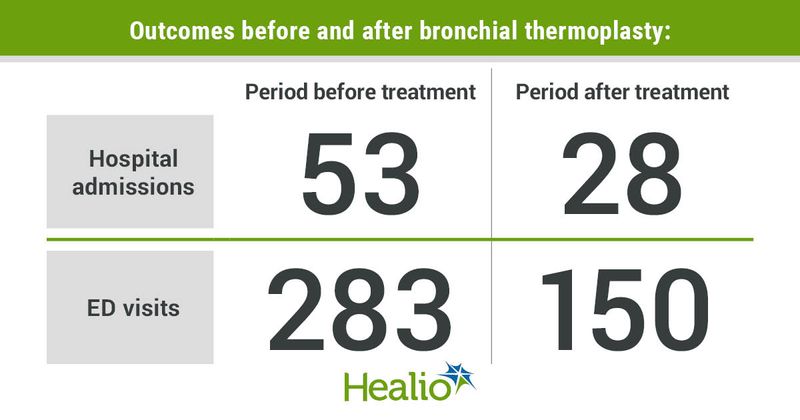Effectiveness of bronchial thermoplasty for asthma varies with BMI, age
Key takeaways:
- Patients experienced 336 adverse outcomes before treatment and 178 afterward.
- Incidence risk ratios for these events included 0.47 for those aged 65 years and younger and 0.7 for those aged older than 65 years.
Bronchial thermoplasty improved outcomes for patients with severe asthma, but its effectiveness varied based on the patients’ baseline profiles, according to a study published in The Journal of Allergy and Clinical Immunology: In Practice.
Specifically, treatment was less effective among older patients and those with higher BMI, Tomohiro Akaba, MD, of the department of clinical epidemiology and health economics at the School of Public Health, University of Tokyo, and colleagues wrote.

The study comprised 102 patients with asthma (30.4% men; median age, 57.5 years; mean BMI, 25.4 kg/m2) treated with bronchial thermoplasty (BT) between September 2014 and March 2020, including 92 patients who completed three BT procedures.
There were 336 outcome events including hospital admissions and ED visits due to asthma exacerbations in the 365 days before BT and 178 events in the 365 days after BT, for an incidence risk ratio (IRR) of 0.53 (95% CI, 0.44-0.64).
Specifically, there more hospital admissions (53 vs. 28; IRR = 0.54; 95% CI, 0.34-0.85) and ED visits (283 vs. 150; IRR = 0.53; 95% CI, 0.43-0.65) in the period before vs. after BT.
Although all age groups and BMI groups experienced significant reductions in these events, IRRs for an outcome event included 0.47 (95% CI, 0.38-0.59) for patients aged 65 years and younger (n = 69) and 0.7 (95% CI, 0.5-0.98) for patients aged older than 65 years (P = .04).
The researchers suggested that the decreased response to treatment among older patients could be attributed to decreases in lung function and airway remodeling by aging or by prolonged duration of disease.
Similarly, IRRs for an outcome event included 0.38 (95% CI, 0.29-0.5) for the 48 patients with a BMI of 25 kg/m2 or less compared with 0.64 (95% CI, 0.5-0.8) for the 54 patients with a BMI higher than 25 kg/m2 (P = .01). Considering these differences, the researchers noted that the accumulation of fat leads to reductions in lung function and metabolic dysregulation.
Total systemic corticosteroid exposure decreased from a median of 1,931.5 mg per person-year (interquartile range [IQR], 1,341.2-3,725.3) before treatment to a median of 641.3 mg per person-year (IQR, 134.2-1,691.1) after BT (P < .001).
Oral corticosteroid (OCS) doses also fell from a median of 1,320.1 mg per person-year (IQR, 981.7-2,731.3) before BT to 393.1 mg per person year (IQR, 0-1354.6) after treatment (P < .001). Additionally, 36.2% of the cohort achieved a 50% or greater reduction in OCS, and 33.3% achieved discontinuation of maintenance OCS.
There were no significant differences in outcomes based on whether patients used biologics, the researchers continued, implying that BT could be added to treatment plans for patients who have uncontrolled type 2 asthma.
Based on these findings, the researchers concluded that BT can be effective for patients with asthma, although that effectiveness may vary based on BMI and age.


